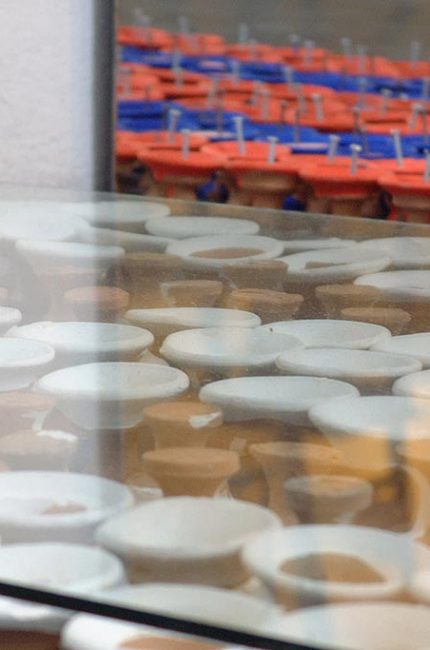From Art Matters by Sushma Joshi
Big signboards painted on fabric greeted the viewer with this question last week in Babar Mahal Revisted: who art thou? usually, the answer would be: thou art part of the expatriate crowd, the upper middle class and the poor journalists who frequent the openings at the siddhartha art gallery. this gathering, fortunately, was a bit more mixed—it had attracted a substantial number of people from the nepali art world, along with little girls decked out in fashionable outfits who had come to view their cousin’s art opening.
sujan chitrakar, the artist, has published an entire text to accompany his artworks. the text, titled “utopian introspection: random expressions within defined periphery” is heavy reading, but as you read along you get flashes of insight, kind of like a hammer hitting a nail on the head. sujan chitrakar, along with colleagues salil subedi, and saroj bajracharya seemed to have spent a lot of time introspecting in front of mirrors, musing on the concept of nails and hammers, and arranging votive earthen diyas in perfect formation. in between, they thought long and hard about the question of life, which seems to have led them to the “mystery of man” as envisioned by fyodor dostoyevsky. even dostoyevsky, however, might have been alternatively baffled and amused by what his words had inspired. the final art products, which must be seen to do them justice, are polished, technically sophisticated and full of the chutzpah that would make them equally at home in new york city as they do in kathmandu.
the excitement of installation lies in its novelty, its use of mixed media, its daring breakage of narrative. in kathmandu, installation is still a new art form, still in the act of destabilizing the supremacy of painting. in western countries where art has fallen over the edge, climbed up and mutated every season since then, installation itself is starting to take on a dated look and feel. walking through a gallery in new york city, one starts to see installations that evoke deja-vu of a genre, like seeing yet another monet inspired painting on a mcdonald’s wall.
paintings may be “sooo last season!” but in spite of it all, old media (paint and canvas, photographs, film) are here to stay. perhaps the reason why traditional media has stuck around for so long is its coherence, and accessibility. the challenge with installation, as with any other art form, is to capture this magnetism that keeps certain media like paint, photography and sculpture solidly entrenched in the popular imagination.
the other challenge is more difficult—indigenizing a borrowed form. chitrakar makes liberal use of recycled tinned milk cans as prayer wheels. in a corner of the gallery, one can find a panel pasted with objects that inspire memories—trinkets and junk one can only find in nepal. as a viewer, i wished there had been more of these playful, juxtaposed forms that play with the notion of nepal and nepaliness, and less of the shiny hammered and nailed works that carry the stamp of generic transnational art that fill the main gallery. the enthusiasm of the artist dispels any confusion. sujan chitrakar is direct, engaged and intense as he talks about his art. meditateonself.com, an online website that is part of this exhibit, is a satire on how meditation is being commercialized and being brought straight to the home, like take-away food. his mixed media work include within them symbols of four religions—islam, hinduism, christianity and buddhism. he feels it is important to be introspective, and create an utopia within oneself, and not look outside for this divine place. he wants to share this idea with his viewers.
a work of art is the interface that allows a viewer to commune with the thoughts and ideas of the artist, its creator. like “being john malkovich,” chitrakar’s utopian introspection often gives the viewer entering the caverns of his thoughts more than they bargained for. taking the advice of the artist then, perhaps the best thing to do after a viewing is to sit down, take a deep breath, and introspect.
Published in Nation Weekly followed by “Art Matters” by Sushma Joshi


